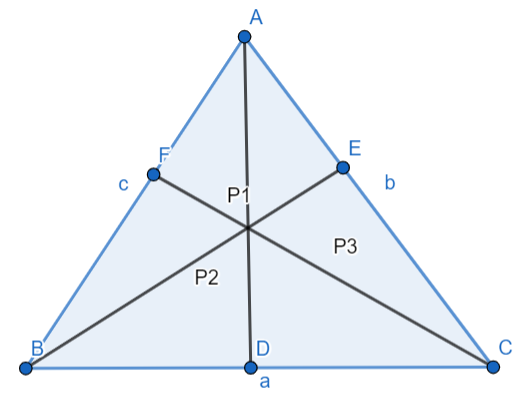
If ${{p}_{1}},{{p}_{2}},{{p}_{3}}$ are respectively the perpendicular from the vertices of a triangle to the opposite sides, then find the value of ${{p}_{1}}{{p}_{2}}{{p}_{3}}$.
Answer
443.7k+ views
Hint: Find the area of triangle by taking three different sets of base and height. Then express ${{p}_{1}}$,${{p}_{2}}$ and ${{p}_{3}}$ in terms of area. After getting the values of ${{p}_{1}}$,${{p}_{2}}$ and ${{p}_{3}}$ multiply them and do the necessary simplification to get the required result.
Complete step by step answer:

Let us consider a triangle $\vartriangle ABC$ with sides a, b and c.
${{p}_{1}},{{p}_{2}},{{p}_{3}}$ are the perpendiculars drawn from the vertices A, B and C respectively.
We know the area of triangle $=\dfrac{1}{2}\times base\times height$
Again let us denote the area of triangle ABC as ‘A’.
Here the area can be expressed in three different ways as we have three different sets of base and height.
So, the area of triangle ABC
$\begin{align}
& A=\dfrac{1}{2}\times BC\times AD \\
& \Rightarrow A=\dfrac{1}{2}\times a\times {{p}_{1}} \\
\end{align}$
So, ${{p}_{1}}$ can be written as
$\Rightarrow {{p}_{1}}=\dfrac{2A}{a}$
Again,
$\begin{align}
& A=\dfrac{1}{2}\times AC\times BE \\
& \Rightarrow A=\dfrac{1}{2}\times b\times {{p}_{2}} \\
\end{align}$
So, ${{p}_{2}}$ can be written as
$\Rightarrow {{p}_{2}}=\dfrac{2A}{b}$
Again,
$\begin{align}
& A=\dfrac{1}{2}\times AC\times CF \\
& \Rightarrow A=\dfrac{1}{2}\times c\times {{p}_{3}} \\
\end{align}$
So, ${{p}_{3}}$ can be written as
$\Rightarrow {{p}_{3}}=\dfrac{2A}{c}$
Hence,
$\begin{align}
& {{p}_{1}}{{p}_{2}}{{p}_{3}}=\dfrac{2A}{a}\times \dfrac{2A}{b}\times \dfrac{2A}{c} \\
& \Rightarrow {{p}_{1}}{{p}_{2}}{{p}_{3}}=\dfrac{8{{A}^{3}}}{abc} \\
\end{align}$
Again as we know \[A=\dfrac{abc}{4R}\] (from sine rule of triangle) where ‘R’ is the radius of the circumcircle.
So, putting the value of ‘A’ in the above expression, we get
$\begin{align}
& \Rightarrow {{p}_{1}}{{p}_{2}}{{p}_{3}}=\dfrac{8{{\left( \dfrac{abc}{4R} \right)}^{3}}}{abc} \\
& \Rightarrow {{p}_{1}}{{p}_{2}}{{p}_{3}}=\dfrac{8{{a}^{3}}{{b}^{3}}{{c}^{3}}}{64{{R}^{3}}abc} \\
& \Rightarrow {{p}_{1}}{{p}_{2}}{{p}_{3}}=\dfrac{{{a}^{2}}{{b}^{2}}{{c}^{2}}}{8{{R}^{3}}} \\
\end{align}$
This is the required solution of the given question.
Note: For the above triangle $\vartriangle ABC$ with sides a, b, c and area ‘A’, the measure of circumradius ‘R’ is $R=\dfrac{abc}{4A}$.
Which can be written as
\[\Rightarrow A=\dfrac{abc}{4R}\]
This value of area is used in the above solution to get the result in a simplified form.
Complete step by step answer:

Let us consider a triangle $\vartriangle ABC$ with sides a, b and c.
${{p}_{1}},{{p}_{2}},{{p}_{3}}$ are the perpendiculars drawn from the vertices A, B and C respectively.
We know the area of triangle $=\dfrac{1}{2}\times base\times height$
Again let us denote the area of triangle ABC as ‘A’.
Here the area can be expressed in three different ways as we have three different sets of base and height.
So, the area of triangle ABC
$\begin{align}
& A=\dfrac{1}{2}\times BC\times AD \\
& \Rightarrow A=\dfrac{1}{2}\times a\times {{p}_{1}} \\
\end{align}$
So, ${{p}_{1}}$ can be written as
$\Rightarrow {{p}_{1}}=\dfrac{2A}{a}$
Again,
$\begin{align}
& A=\dfrac{1}{2}\times AC\times BE \\
& \Rightarrow A=\dfrac{1}{2}\times b\times {{p}_{2}} \\
\end{align}$
So, ${{p}_{2}}$ can be written as
$\Rightarrow {{p}_{2}}=\dfrac{2A}{b}$
Again,
$\begin{align}
& A=\dfrac{1}{2}\times AC\times CF \\
& \Rightarrow A=\dfrac{1}{2}\times c\times {{p}_{3}} \\
\end{align}$
So, ${{p}_{3}}$ can be written as
$\Rightarrow {{p}_{3}}=\dfrac{2A}{c}$
Hence,
$\begin{align}
& {{p}_{1}}{{p}_{2}}{{p}_{3}}=\dfrac{2A}{a}\times \dfrac{2A}{b}\times \dfrac{2A}{c} \\
& \Rightarrow {{p}_{1}}{{p}_{2}}{{p}_{3}}=\dfrac{8{{A}^{3}}}{abc} \\
\end{align}$
Again as we know \[A=\dfrac{abc}{4R}\] (from sine rule of triangle) where ‘R’ is the radius of the circumcircle.
So, putting the value of ‘A’ in the above expression, we get
$\begin{align}
& \Rightarrow {{p}_{1}}{{p}_{2}}{{p}_{3}}=\dfrac{8{{\left( \dfrac{abc}{4R} \right)}^{3}}}{abc} \\
& \Rightarrow {{p}_{1}}{{p}_{2}}{{p}_{3}}=\dfrac{8{{a}^{3}}{{b}^{3}}{{c}^{3}}}{64{{R}^{3}}abc} \\
& \Rightarrow {{p}_{1}}{{p}_{2}}{{p}_{3}}=\dfrac{{{a}^{2}}{{b}^{2}}{{c}^{2}}}{8{{R}^{3}}} \\
\end{align}$
This is the required solution of the given question.
Note: For the above triangle $\vartriangle ABC$ with sides a, b, c and area ‘A’, the measure of circumradius ‘R’ is $R=\dfrac{abc}{4A}$.
Which can be written as
\[\Rightarrow A=\dfrac{abc}{4R}\]
This value of area is used in the above solution to get the result in a simplified form.
Recently Updated Pages
What percentage of the area in India is covered by class 10 social science CBSE

The area of a 6m wide road outside a garden in all class 10 maths CBSE

What is the electric flux through a cube of side 1 class 10 physics CBSE

If one root of x2 x k 0 maybe the square of the other class 10 maths CBSE

The radius and height of a cylinder are in the ratio class 10 maths CBSE

An almirah is sold for 5400 Rs after allowing a discount class 10 maths CBSE

Trending doubts
The Equation xxx + 2 is Satisfied when x is Equal to Class 10 Maths

Why is there a time difference of about 5 hours between class 10 social science CBSE

Change the following sentences into negative and interrogative class 10 english CBSE

Write a letter to the principal requesting him to grant class 10 english CBSE

Explain the Treaty of Vienna of 1815 class 10 social science CBSE

Write an application to the principal requesting five class 10 english CBSE




